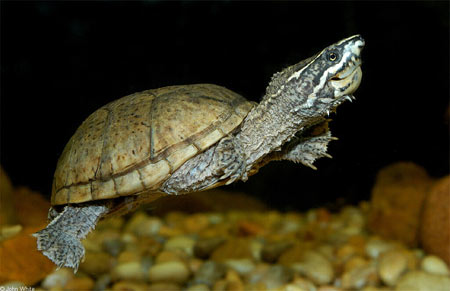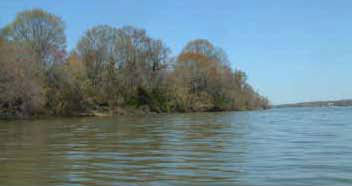Field Guide to Maryland's Turtles (Order Testudines)
Main_Content
Eastern Musk Turtle (Sternotherus odoratus) | | Common Name:
|

Photo of Eastern Musk Turtle courtesy of John White
|
Size: 2 - 4½ inches. Record - 5 inches |
Appearance:Also known as “Stinkpot”, its fetid smell aids in identification.
- The bottom shell, or plastron, is reduced with the front half or lobe having an inconspicuous single hinge.
- The gular scute, or "scale" closest to the head on the plastron, is not divided (as it is in most other turtles).
- The pectoral scutes are squarish (vs. triangular in mud turtle).
- Two light stripes (yellowish or white) on head and neck, and barbells, whisker-like organs, on chin and throat.
- The highly arched smooth carapace (top shell) is olive brown to black and often has green algae growing on it.

Photo of Habitat for Eastern Musk Turtle courtesy of Rebecca Chalmers
|
Habitats:Found in most permanent bodies of water with slow current and soft
bottoms, including ponds, lakes, swamps, streams and rivers. It is not found
in brackish waters. Often climbs slanting trees on swamp and marsh edges,
where they occasionally fall onto boaters.
|
How to Find:Look in shallow water areas from April to September, particularly areas
of still water. It is chiefly nocturnal, resting on the bottom during the
day. It can sometimes be observed through binoculars basking on trees. May
be ill-tempered if handled.
|
Distribution in Maryland:Can be found throughout Maryland but more common on the Coastal Plain.

|
|
